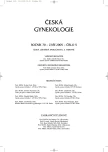Changes in Values of Urethral Closure Pressure and its Position after TVT Operation – Predictive Value of MUCP and VLPP for Successful Rate of this Operation
Authors:
A. Martan 1; J. Mašata 1; K. Švabík 1; P. Drahorádová 1; M. Pavlikova 2; J. Hlásenská 2
Authors‘ workplace:
Gynekologicko-porodnická klinika 1. LF UK a VFN, Praha, přednosta prof. MUDr. A. Martan, DrSc.
1; EuroMISE centrum UK a AVČR, Praha, ředitelka prof. RNDr. J. Zvárová, DrSc.
2
Published in:
Ceska Gynekol 2005; 70(5): 370-376
Category:
Original Article
Overview
Objective:
To ascertain how the TVT (tension free vaginal tape) operation affects the value and position of MUCP in women without any previous uro-gynaecological operation. If possible, also to determine how the values of these parameters differ between groups of women who are free from problems after the operation, women who suffer urgency, and women who continue to suffer from stress incontinence. Furthermore, to ascertain whether the pre-operation values of MUCP and VLPP have any predictive value in determining the success rate of TVT operation. In addition, to ascertain whether in ultrasound examination we can observe any differences in urethra mobility between subgroups of women with various operation results.
Design:
Cross-sectional clinical study.
Settings:
Gynecological and Obstetric Clinic, First School of Medicine of Charles University and General Faculty Hospital, Prague.
Materials and Methods:
59 women after TVT operation were included in the study. The average age was 54.8 (SD=10.5), BMI 27.6 (SD=4.7) and parity 1.9 (SD=0.6). A urodynamic examination was performed in the patient in the supine position, the urinary bladder was filled with 300 and 500 ml of normal saline solution. The pressure profile was examined at rest, at maximal Valsalva manoeuvre and while coughing. During examination of the urethral pressure profile we ascertained MUCP, the functional length of the urethra (FUL) and the relative distance of the MUCP point from the inner urethral orifice, which was calculated as the ratio of the MUCP position with respect to FUL. To determine the position and mobility of urethra, perineal ultrasound examination was performed in patients in supine position, using Acuson 128 XP 10 equipment, 5 MHz convex abdominal probe. The bladder was filled with 300 ml of saline. Polar coordinates (distance p, angle gamma) were employed when determining the position of UVJ and of the centre of urethra, defined at 17 mm distance from inner urethral orifice. Of the 59 patients who underwent the operation, 47 subsequently had no problems (A), 8 suffered with urgency symptoms (B), and in 4 (C) mild stress incontinence still persisted. The data were summarised as means with SD and as medians. Measurements before and after the operation were compared using the paired t-test and paired Wilcoxon test where appropriate. Groups A, B, C were compared using Kruskal-Wallis test or Pearson χ2-test where appropriate. The level of significance was set to 0.05. Statistical software R version 2.0.1 was used throughout the analysis.
Results:
No statistically significant changes were observed in values of MUCP before and after surgery, at rest, at Valsalva or while coughing, or with varying volumes of the urinary bladder of 300 and 500 ml. Nor did we observe any difference in values of MUCP between the individual subgroups (A, B, C) of patients after surgery.
We observed mild shortening of FUL at both volumes of the bladder at rest, but no change was observed at Valsalva. The distance of the point of MUCP from the inner urethral orifice was shifted by the operation, from 44% to 57% at rest; the small shift at Valsalva was not statistically significant. No statistically significant differences in these parameters were observed between subgroups A, B, C.
In the group of patients with MUCP before surgery < 30 cm H2O, 67% women were without problems after the operation. Among women with MUCP >30 cm H2O, 84% were without problems. This difference, however, was not statistically significant. The same is valid for women with VLPP < 60 cm H2O and VLPP > 60 cm H2O between these groups there was no statistically significant difference in success rate of this operation. The results of ultrasound examination imply that the operation does not change the position of UVJ or the middle of urethra at rest; however, it affects the position of urethra at Valsalva manoeuvre, the scope of the movement being smaller after the operation.
Conclusions:
The results of our study imply that the tape in TVT operation, if properly placed and not tight, does not change MUCP either at rest or at Valsalva. The operation slightly shortens the FUL at rest and causes a minor shift of the MUCP point towards the outer urethral orifice. The operation also does not change the position of the urethra at rest while restricting its movement during Valsalva manoeuver. For the group of patients who suffer urgency after the operation we observed slight change in direction of movement of UVJ during Valsalva manoeuver; UVJ being pulled lower and towards symphysis as compared to patients who are free from problems after the operation. Pre-operation values of MUCP and VLPP cannot be used to predict the effect of the operation, though we are aware of the fact that our results were ascertained on a rather small number of patients in the groups of patients with complications.
Key words:
female urinary incontinence, urethral hypermobility, maximum urethral closure pressure, Valsalva leak-point pressure
Labels
Paediatric gynaecology Gynaecology and obstetrics Reproduction medicineArticle was published in
Czech Gynaecology

2005 Issue 5
Most read in this issue
- The Perineal Body Length and Injury at Delivery
- Embolization of Uterine Arteries during Myoma Treatment from the Patient’s Point of View
- Antifungal Effect in Selected Natural Compounds and Probiotics and their Possible Use in Prophylaxis of Vulvovaginitis
- Does Oocyte Retrieval Influence the Following Morphological Quality of Embryos?
